Chris Develder
Model Predictive Control-Guided Reinforcement Learning for Implicit Balancing
Oct 06, 2025



Abstract:In Europe, profit-seeking balance responsible parties can deviate in real time from their day-ahead nominations to assist transmission system operators in maintaining the supply-demand balance. Model predictive control (MPC) strategies to exploit these implicit balancing strategies capture arbitrage opportunities, but fail to accurately capture the price-formation process in the European imbalance markets and face high computational costs. Model-free reinforcement learning (RL) methods are fast to execute, but require data-intensive training and usually rely on real-time and historical data for decision-making. This paper proposes an MPC-guided RL method that combines the complementary strengths of both MPC and RL. The proposed method can effectively incorporate forecasts into the decision-making process (as in MPC), while maintaining the fast inference capability of RL. The performance of the proposed method is evaluated on the implicit balancing battery control problem using Belgian balancing data from 2023. First, we analyze the performance of the standalone state-of-the-art RL and MPC methods from various angles, to highlight their individual strengths and limitations. Next, we show an arbitrage profit benefit of the proposed MPC-guided RL method of 16.15% and 54.36%, compared to standalone RL and MPC.
Efficient Text Encoders for Labor Market Analysis
May 30, 2025Abstract:Labor market analysis relies on extracting insights from job advertisements, which provide valuable yet unstructured information on job titles and corresponding skill requirements. While state-of-the-art methods for skill extraction achieve strong performance, they depend on large language models (LLMs), which are computationally expensive and slow. In this paper, we propose \textbf{ConTeXT-match}, a novel contrastive learning approach with token-level attention that is well-suited for the extreme multi-label classification task of skill classification. \textbf{ConTeXT-match} significantly improves skill extraction efficiency and performance, achieving state-of-the-art results with a lightweight bi-encoder model. To support robust evaluation, we introduce \textbf{Skill-XL}, a new benchmark with exhaustive, sentence-level skill annotations that explicitly address the redundancy in the large label space. Finally, we present \textbf{JobBERT V2}, an improved job title normalization model that leverages extracted skills to produce high-quality job title representations. Experiments demonstrate that our models are efficient, accurate, and scalable, making them ideal for large-scale, real-time labor market analysis.
Single- vs. Dual-Prompt Dialogue Generation with LLMs for Job Interviews in Human Resources
Feb 25, 2025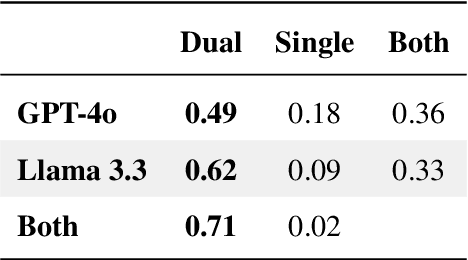
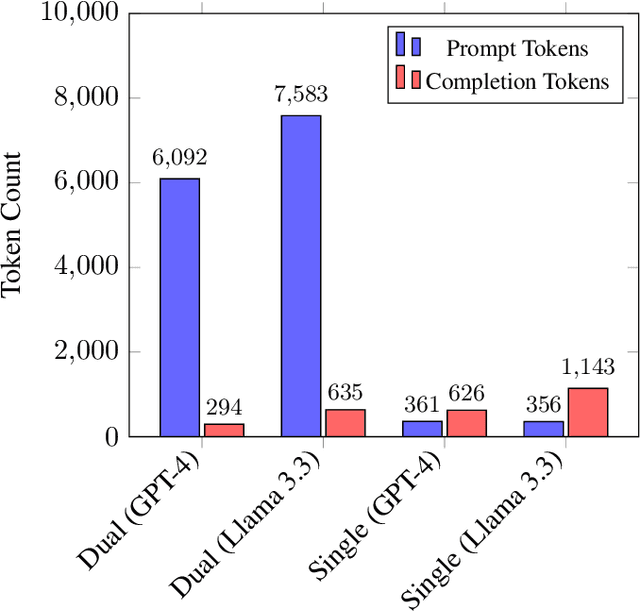
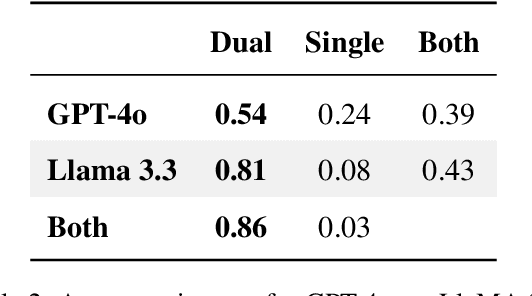
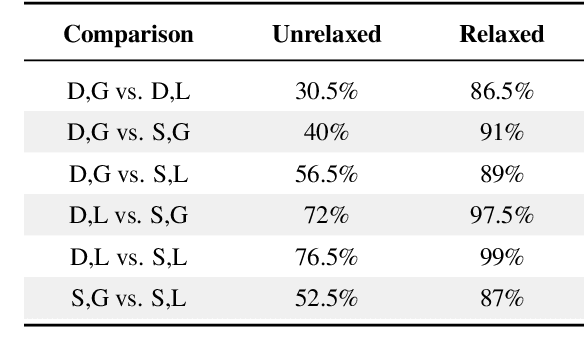
Abstract:Optimizing language models for use in conversational agents requires large quantities of example dialogues. Increasingly, these dialogues are synthetically generated by using powerful large language models (LLMs), especially in domains with challenges to obtain authentic human data. One such domain is human resources (HR). In this context, we compare two LLM-based dialogue generation methods for the use case of generating HR job interviews, and assess whether one method generates higher-quality dialogues that are more challenging to distinguish from genuine human discourse. The first method uses a single prompt to generate the complete interview dialog. The second method uses two agents that converse with each other. To evaluate dialogue quality under each method, we ask a judge LLM to determine whether AI was used for interview generation, using pairwise interview comparisons. We demonstrate that despite a sixfold increase in token cost, interviews generated with the dual-prompt method achieve a win rate up to ten times higher than those generated with the single-prompt method. This difference remains consistent regardless of whether GPT-4o or Llama 3.3 70B is used for either interview generation or judging quality.
Predicting and Publishing Accurate Imbalance Prices Using Monte Carlo Tree Search
Nov 06, 2024Abstract:The growing reliance on renewable energy sources, particularly solar and wind, has introduced challenges due to their uncontrollable production. This complicates maintaining the electrical grid balance, prompting some transmission system operators in Western Europe to implement imbalance tariffs that penalize unsustainable power deviations. These tariffs create an implicit demand response framework to mitigate grid instability. Yet, several challenges limit active participation. In Belgium, for example, imbalance prices are only calculated at the end of each 15-minute settlement period, creating high risk due to price uncertainty. This risk is further amplified by the inherent volatility of imbalance prices, discouraging participation. Although transmission system operators provide minute-based price predictions, the system imbalance volatility makes accurate price predictions challenging to obtain and requires sophisticated techniques. Moreover, publishing price estimates can prompt participants to adjust their schedules, potentially affecting the system balance and the final price, adding further complexity. To address these challenges, we propose a Monte Carlo Tree Search method that publishes accurate imbalance prices while accounting for potential response actions. Our approach models the system dynamics using a neural network forecaster and a cluster of virtual batteries controlled by reinforcement learning agents. Compared to Belgium's current publication method, our technique improves price accuracy by 20.4% under ideal conditions and by 12.8% in more realistic scenarios. This research addresses an unexplored, yet crucial problem, positioning this paper as a pioneering work in analyzing the potential of more advanced imbalance price publishing techniques.
SkillMatch: Evaluating Self-supervised Learning of Skill Relatedness
Oct 07, 2024


Abstract:Accurately modeling the relationships between skills is a crucial part of human resources processes such as recruitment and employee development. Yet, no benchmarks exist to evaluate such methods directly. We construct and release SkillMatch, a benchmark for the task of skill relatedness, based on expert knowledge mining from millions of job ads. Additionally, we propose a scalable self-supervised learning technique to adapt a Sentence-BERT model based on skill co-occurrence in job ads. This new method greatly surpasses traditional models for skill relatedness as measured on SkillMatch. By releasing SkillMatch publicly, we aim to contribute a foundation for research towards increased accuracy and transparency of skill-based recommendation systems.
On the Biased Assessment of Expert Finding Systems
Oct 07, 2024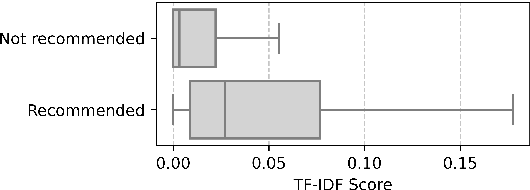

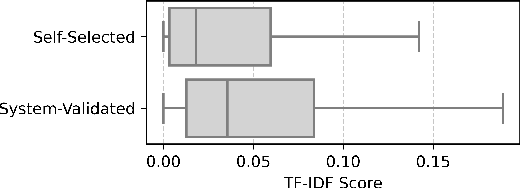
Abstract:In large organisations, identifying experts on a given topic is crucial in leveraging the internal knowledge spread across teams and departments. So-called enterprise expert retrieval systems automatically discover and structure employees' expertise based on the vast amount of heterogeneous data available about them and the work they perform. Evaluating these systems requires comprehensive ground truth expert annotations, which are hard to obtain. Therefore, the annotation process typically relies on automated recommendations of knowledge areas to validate. This case study provides an analysis of how these recommendations can impact the evaluation of expert finding systems. We demonstrate on a popular benchmark that system-validated annotations lead to overestimated performance of traditional term-based retrieval models and even invalidate comparisons with more recent neural methods. We also augment knowledge areas with synonyms to uncover a strong bias towards literal mentions of their constituent words. Finally, we propose constraints to the annotation process to prevent these biased evaluations, and show that this still allows annotation suggestions of high utility. These findings should inform benchmark creation or selection for expert finding, to guarantee meaningful comparison of methods.
Anchored Preference Optimization and Contrastive Revisions: Addressing Underspecification in Alignment
Aug 12, 2024



Abstract:Large Language Models (LLMs) are often aligned using contrastive alignment objectives and preference pair datasets. The interaction between model, paired data, and objective makes alignment a complicated procedure, sometimes producing subpar results. We study this and find that (i) preference data gives a better learning signal when the underlying responses are contrastive, and (ii) alignment objectives lead to better performance when they specify more control over the model during training. Based on these insights, we introduce Contrastive Learning from AI Revisions (CLAIR), a data-creation method which leads to more contrastive preference pairs, and Anchored Preference Optimization (APO), a controllable and more stable alignment objective. We align Llama-3-8B-Instruct using various comparable datasets and alignment objectives and measure MixEval-Hard scores, which correlate highly with human judgments. The CLAIR preferences lead to the strongest performance out of all datasets, and APO consistently outperforms less controllable objectives. Our best model, trained on 32K CLAIR preferences with APO, improves Llama-3-8B-Instruct by 7.65%, closing the gap with GPT4-turbo by 45%. Our code is available at https://github.com/ContextualAI/CLAIR_and_APO.
Control Policy Correction Framework for Reinforcement Learning-based Energy Arbitrage Strategies
Apr 30, 2024



Abstract:A continuous rise in the penetration of renewable energy sources, along with the use of the single imbalance pricing, provides a new opportunity for balance responsible parties to reduce their cost through energy arbitrage in the imbalance settlement mechanism. Model-free reinforcement learning (RL) methods are an appropriate choice for solving the energy arbitrage problem due to their outstanding performance in solving complex stochastic sequential problems. However, RL is rarely deployed in real-world applications since its learned policy does not necessarily guarantee safety during the execution phase. In this paper, we propose a new RL-based control framework for batteries to obtain a safe energy arbitrage strategy in the imbalance settlement mechanism. In our proposed control framework, the agent initially aims to optimize the arbitrage revenue. Subsequently, in the post-processing step, we correct (constrain) the learned policy following a knowledge distillation process based on properties that follow human intuition. Our post-processing step is a generic method and is not restricted to the energy arbitrage domain. We use the Belgian imbalance price of 2023 to evaluate the performance of our proposed framework. Furthermore, we deploy our proposed control framework on a real battery to show its capability in the real world.
Probabilistic forecasting of power system imbalance using neural network-based ensembles
Apr 24, 2024



Abstract:Keeping the balance between electricity generation and consumption is becoming increasingly challenging and costly, mainly due to the rising share of renewables, electric vehicles and heat pumps and electrification of industrial processes. Accurate imbalance forecasts, along with reliable uncertainty estimations, enable transmission system operators (TSOs) to dispatch appropriate reserve volumes, reducing balancing costs. Further, market parties can use these probabilistic forecasts to design strategies that exploit asset flexibility to help balance the grid, generating revenue with known risks. Despite its importance, literature regarding system imbalance (SI) forecasting is limited. Further, existing methods do not focus on situations with high imbalance magnitude, which are crucial to forecast accurately for both TSOs and market parties. Hence, we propose an ensemble of C-VSNs, which are our adaptation of variable selection networks (VSNs). Each minute, our model predicts the imbalance of the current and upcoming two quarter-hours, along with uncertainty estimations on these forecasts. We evaluate our approach by forecasting the imbalance of Belgium, where high imbalance magnitude is defined as $|$SI$| > 500\,$MW (occurs 1.3% of the time in Belgium). For high imbalance magnitude situations, our model outperforms the state-of-the-art by 23.4% (in terms of continuous ranked probability score (CRPS), which evaluates probabilistic forecasts), while also attaining a 6.5% improvement in overall CRPS. Similar improvements are achieved in terms of root-mean-squared error. Additionally, we developed a fine-tuning methodology to effectively include new inputs with limited history in our model. This work was performed in collaboration with Elia (the Belgian TSO) to further improve their imbalance forecasts, demonstrating the relevance of our work.
Explainable Reinforcement Learning-based Home Energy Management Systems using Differentiable Decision Trees
Mar 18, 2024Abstract:With the ongoing energy transition, demand-side flexibility has become an important aspect of the modern power grid for providing grid support and allowing further integration of sustainable energy sources. Besides traditional sources, the residential sector is another major and largely untapped source of flexibility, driven by the increased adoption of solar PV, home batteries, and EVs. However, unlocking this residential flexibility is challenging as it requires a control framework that can effectively manage household energy consumption, and maintain user comfort while being readily scalable across different, diverse houses. We aim to address this challenging problem and introduce a reinforcement learning-based approach using differentiable decision trees. This approach integrates the scalability of data-driven reinforcement learning with the explainability of (differentiable) decision trees. This leads to a controller that can be easily adapted across different houses and provides a simple control policy that can be explained to end-users, further improving user acceptance. As a proof-of-concept, we analyze our method using a home energy management problem, comparing its performance with commercially available rule-based baseline and standard neural network-based RL controllers. Through this preliminary study, we show that the performance of our proposed method is comparable to standard RL-based controllers, outperforming baseline controllers by ~20% in terms of daily cost savings while being straightforward to explain.
 Add to Chrome
Add to Chrome Add to Firefox
Add to Firefox Add to Edge
Add to Edge